All English teachers encourage their students to read, anything really, but particularly well-written texts. This is where mentor texts come in. In this post, we will unpack what a mentor text is and how to choose one for the classroom. You will also learn how to use them effectively for teaching.
Table of Contents
- What Is A Mentor Text?
- Why Use Personal Narrative Mentor Texts?
- Benefits Of Using Mentor Texts
- Qualities Of A Good Mentor Text
- How Do I Choose A Mentor Text?
- Steps To Implementing Mentor Text Teachings
- Using Mentor Texts In All Subjects:
- 9 Tips For More Effective Teaching With Mentor Text
- Mentor Text FAQs
- Final thoughts about mentor texts
What Is A Mentor Text?
A mentor text is a well-written piece of writing from which students can learn to improve their writing.
Mentor texts can be of any length, genre, style or format, and can have been written for any audience and for any purpose. They must be age or grade-appropriate, as well as examples of the specific type of writing that is being taught.

There is no point in using a classic poem as a mentor text if your students are learning to write a newspaper article. Similarly, if the subject of the class is narrative writing, then don’t select an opinion piece. You should also not choose a 3rd-grade picture book about dinosaurs as a mentor text for your 6th graders who are writing factually about pollution.
Why Use Personal Narrative Mentor Texts?
Most writing that students do at school is personal because they find it easier to write from their own experiences. They should be taught to develop their writing from a personal perspective.
This is where personal narrative mentor texts come in. By choosing to expose your students to examples of good writing of this nature, you will be able to help them identify the features of these texts they can apply to their own writing
Benefits Of Using Mentor Texts
Using mentor texts has benefits other than teaching aspects of writing.
Book-Based Skill
Identifying good writing helps students choose books and writing styles from which they will learn. They will also gather important skills for structuring stories, building plots and characters, and writing engaging dialogue.
Thinking Out Loud
So much of what we put on paper begins in our heads. It is often easier to make sense of ideas if we listen to ourselves working things out. By speaking about a text, the students are learning to do this, which they can link to their own ideas and writing.
Listening Skill
If you read a text aloud and let individual students voice their ideas and lead discussions, you will encourage them to hone their listening skills. We can teach our students to read like writers (Marchetti, A. & O’Dell, R., ), by teaching them to listen effectively when they read their own work.
Target Skills
Using a mentor text to help students learn about writing is also an opportunity to teach them about more specific elements of language, like Parts of Speech and grammar. You can target the skills of writing, as well as language studies in general.
Engage
How can you learn without becoming involved? With mentor texts, students must focus on aspects of the writing, so they can analyse them and talk knowledgeably about them. They then need to engage with these points and apply them to their own writing.

Qualities Of A Good Mentor Text
A good mentor text should have some specific qualities:
The overarching topic must be clearly presented.
This doesn’t necessarily mean that the guiding idea will be stated at the beginning of the text, as may be appropriate in an opinion piece, or even a description. In a narrative piece, the idea will emerge, rather than be stated. While reading the text, it must become clear.
The text must be logically and efficiently organized
This relates to the structure of the piece and the development of ideas. In terms of formatting, for example, newspaper articles should follow the inverted triangle structure, with the meat of the piece being in the introduction and first few paragraphs. A persuasive piece, on the other hand, must begin by stating the writer’s point of argument clearly in the beginning and should then present points of argument that are expanded upon.
The voice of the author must come through clearly
Avoid choosing a text that is rather ‘wishy-washy’, with different positions and styles being used almost ad hoc. Any good piece of writing will have a strong and specific style, which includes the tone, choice of vocab and syntax.
The grammar must be correct
Don’t select a piece of writing that has multiple grammatical errors. The mark of a well-written piece is that it is efficiently proofread and error-free. Of course, there are always exceptions where the author has specifically used, for example, incomplete sentences. I suggest avoiding using this type of piece as a mentor text, especially in the lower grades.
suit the topic, level and type of writing.
A good mentor text doesn’t have to make use of ‘fancy’ words. The register and vocabulary must be appropriate for the type of writing and the audience. A text that is aimed at sophisticated readers cannot use colloquial, low register vocabulary and be an effective text.
The text must use the conventions of the genre effectively.
Every text has characteristics of content, formatting, readability and shape, which are specific to the genre, or type of writing. A good mentor text must demonstrate the appropriate elements of the particular genre being written.

How Do I Choose A Mentor Text?
Choosing a mentor text is not simply going to your stock of newspapers, magazines or books and pulling out a piece of writing. I mean, if it’s been published, it must be good, right? Unfortunately, if a piece of writing has been published, it means it has a readership. It does not necessarily mean it is well written.
To choose a mentor text, you must begin with the age of your students. You won’t even look at an editorial from Time magazine for 5th graders, just as you won’t go for a ‘learn to read’ book for 12th graders.
The next step is to consider the genre or type of text you are looking for. This links directly to the type of writing you are teaching your students. If you are teaching narrative writing, look at novels, stories or personal narratives, such as travel pieces that tell a story.
Finally, apply your own experience and the criteria above to ascertain if the text you are looking at will really be an example of good writing. If so, you have found your mentor text!
There are various resources that will supply mentor texts for teaching narrative writing or opinion or persuasive writing. Our Fictional Narrative Writing Unit will give you mentor texts to work with, as well as other useful resources.
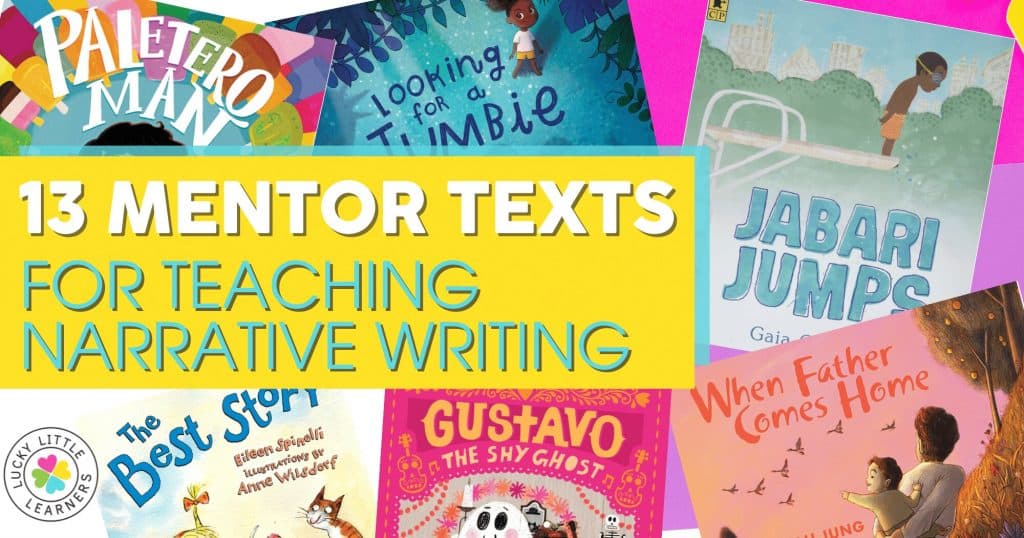
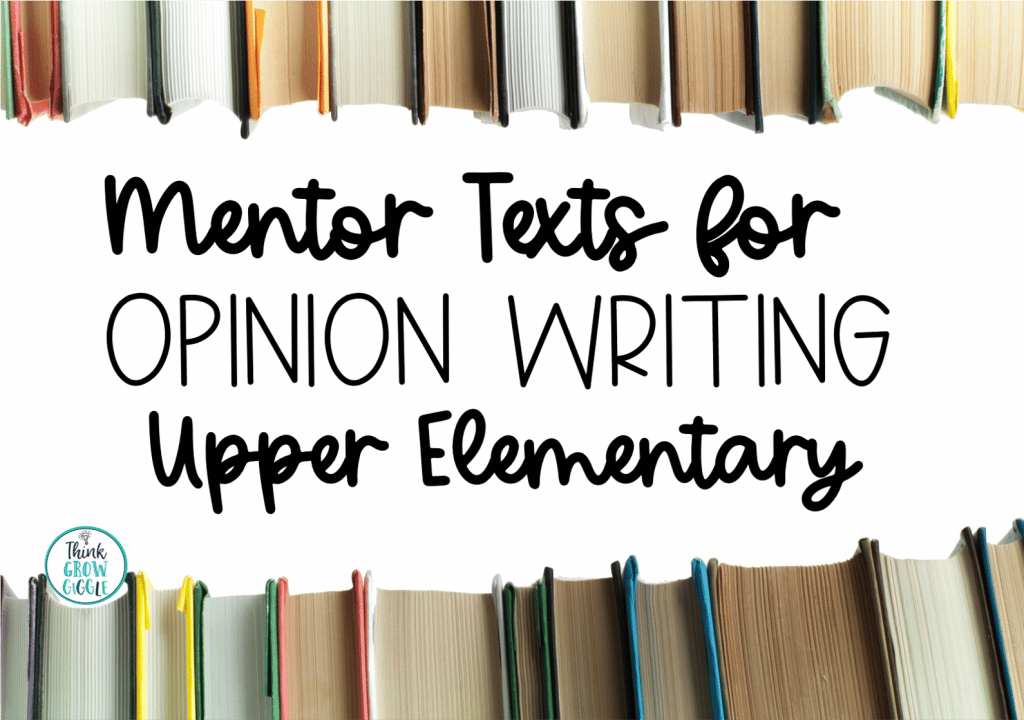

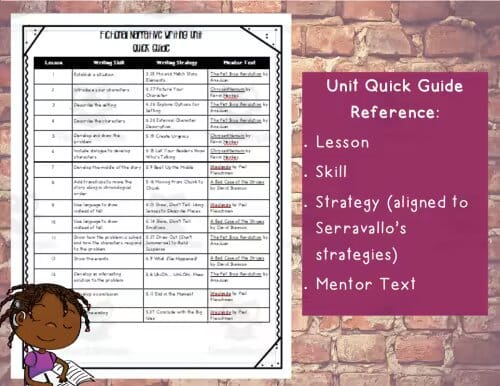
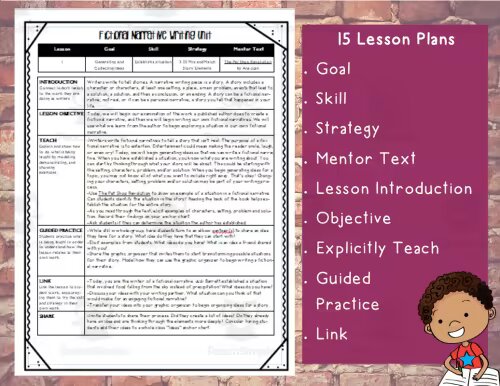
For Grades 4 – 6, our unit, Plan and Write Lots of Stories, includes texts and programs of writing specific types of stories.

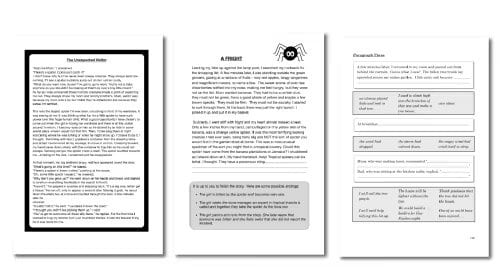
Steps To Implementing Mentor Text Teachings
When you use a mentor text in the classroom, you should approach it step-by-step.
1. Recognize Mentor Text
It is worth re-stating that the first thing you need to do is to make sure you choose an appropriate text.
2. Read
Read the entire text to the class. This may be a relatively short piece, or it may be an extract from a longer text, such as a novel. Don’t stop in your reading for any discussion or explanation.
3. Ask Questions
Ask the students pointed questions about the text. This should not be based on their understanding but on their opinion of the writing. For example:
- Did you understand the main point of the piece? Why or why not?
- Can you describe the style of the writing?
- Why did the writer use the particular diction?
- What made this piece interesting, or boring, perhaps?
4. Read Again
Now, read the piece again and ask the students to write down anything they find good or bad about the writing.
5. Discuss
Discuss these ideas with the class, allowing individual students to identify particular features and to explain their choice/s.
6. Analyse The Text
A mentor text doesn’t need to be picked apart in every aspect. Rather, choose an element of writing, such as grammar, and work on that. Ask the students to answer questions such as: Are there any errors? Are they deliberate? What is the effect?
You can do this with different elements of the writing.
7. Write
Allow the students to work on their piece of writing, concentrating on each of the elements they have discussed in the mentor text. Don’t expect them to do this all at once. If, for example, they are working on building characters in a story, then don’t look for perfect grammar
8. Feedback
Read the students’ writing and give them feedback, focusing on the specific elements they have worked on. Make sure your overall tone is positive and make clear connections to the mentor text. If you think a student can improve on an aspect of the writing, then direct them back to the mentor text as an example.

Using Mentor Texts In All Subjects:
Mentor texts can be used in different subjects.
Writing
Most obviously, mentor texts are a great resource to help students to learn about writing and to hone their own skills.
Reading
Not only do mentor texts present examples of good use of English, they also teach students to listen as writers. This is about listening to the content and to the way the text is written.
Math
Looking for a mentor text to teach math may seem a bit out of left field. Why not, though? Story sums are just that, aren’t they? Stories. Use simple narrative texts to help your students understand the logic of a storyline.
Social Studies
Using mentor texts to teach the social sciences must be the best way of exposing students to different histories, cultures and peoples. How would we know about the Civil War, for example, without letters, reports and stories? These are examples of mentor texts.
Sciences
Studying the sciences is not only about experiments, the periodic table and gases. It’s also about understanding concepts and exploring the background to discoveries and elements. Why not, then, use a report about Marie Curie to teach your students about radioactivity? We all, surely, remember the story about Newton sitting under the apple tree when he identified gravity, don’t we?

9 Tips For More Effective Teaching With Mentor Text
Tip 1: Focus
When you analyse a mentor text with the class, make sure you focus on only one aspect of the writing at a time.
Tip 2: Variety
Choose a variety of mentor texts for the classroom, especially for narrative writing. Individual students write differently from each other. Where a few may learn a lot from one mentor text, you may find that others may respond better to an alternative style or voice.
Tip 3: Context
Begin by introducing the students to the text. Explain the context and even the basic storyline, or argument. This will help them to listen beyond the ‘plot’ and focus on the writing.
Tip 4: Read Aloud
Encourage the students to read their own work aloud often. This helps them to listen to what they have written as readers, not as writers.
Tip 5: Enjoyment
Choose texts that you enjoy reading. You won’t be able to communicate their value to students if you don’t truly believe in them.
Tip 6: Overlap Learning
Use a mentor text, such as a well-written travel blog, in the geography classroom to introduce the class to a particular area.
Tip 7: Focus on Writing
Don’t keep the focus only on the mentor text. Make sure you keep working on the students’ writing and encouraging them to share.
Tip 8: Peer Feedback
Set up opportunities for peer feedback. The students should share their writing with their partner, who will comment on the way they have adopted a feature of the mentor texts.
Tip 8: Age & Grade Appropriate
Always make sure that the mentor texts you use are appropriate for the grade and age of your students.
Mentor Text FAQs
The best source of mentor texts is most likely to be your teaching resource library. You can also visit the library, buy newspapers and magazines, or use online blogs. There are also various sites on the internet that offer samples of mentor texts.
A lesson plan is literally an outline of every step of a lesson. It also needs to include any resources to be used in giving the lesson. This means that, if you are using a mentor text in your lesson, it must be included in the plan.
A huge part of teaching from a mentor text is for students to listen to the way the text is written. They also need to discuss what they observe, which means listening to each other. Ultimately, students will read their own work aloud and must learn to listen as a reader, not a writer.
Final thoughts about mentor texts
A mentor text is an invaluable teaching tool, particularly when it comes to helping a student learn about writing and improving their own work. It doesn’t stop there, though. Mentor texts can be used in a variety of ways and in a range of subjects. You just need to be a little creative in your thinking.
